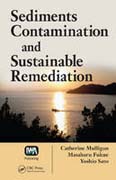
Sediments contamination and sustainable remediation
Mulligan, Catherine N.
Fukue, Masaharu
Sato, Yoshio
A comprehensive resource, this book opens with discussions of the contamination of sediments resulting from discharge of pollutants, excessive nutrients, and other hazardous substances from anthropogenic activities. It examines impacts observed as a result of these discharges, including the presence of hazardous materials and the phenomenon of eutrophication, and elucidates the remediation techniques developed to restore the health of sediments and how to evaluate the remediation technologies using indicators. The text highlights the problems inherent when dealing with contaminated sediments in rivers, lakes, and estuaries and includes numerous case studies that illustrate key concepts. INDICE: Ch. 1. Introduction to Sediment Contamination and Management -- Ch. 2. Introduction to Sediments -- Ch. 3. Contaminant-Sediment Interactions -- Ch. 4. Remediation Assessment, Sampling, and Monitoring -- Ch. 5. Natural Recovery of Contaminated Sediments -- Ch. 6. In Situ Remediation and Management ofContaminated Sediments -- Ch. 7. Dredging and the Remediation of Dredged Contaminated Sediments -- Ch. 8. Management and Evaluation of Treatment Alternatives for Sediments -- Ch. 9. Current State and Future Directions -- Appendix A. Sediment Quality Guidelines from Environment Canada and MDDEP, 2008 -- Appendix B. London Convention and Protocol: Convention on the Prevention of Marine Pollution by Dumping of Wastes and Other Matter, 1972 -- Appendix C. Prediction of Sediment Toxicity Using Consensus Based Freshwater Sediment Quality Guidelines: USGS. 2000. Prediction of sediment toxicity using consensus based freshwater sediment quality guidelines. EPA 905/R-OO/007, June 2000 -- Appendix D. International Sediment Quality Criteria.
- ISBN: 978-1-4200-6153-6
- Editorial: CRC Press
- Encuadernacion: Rústica
- Páginas: 320
- Fecha Publicación: 14/12/2009
- Nº Volúmenes: 1
- Idioma: Inglés
